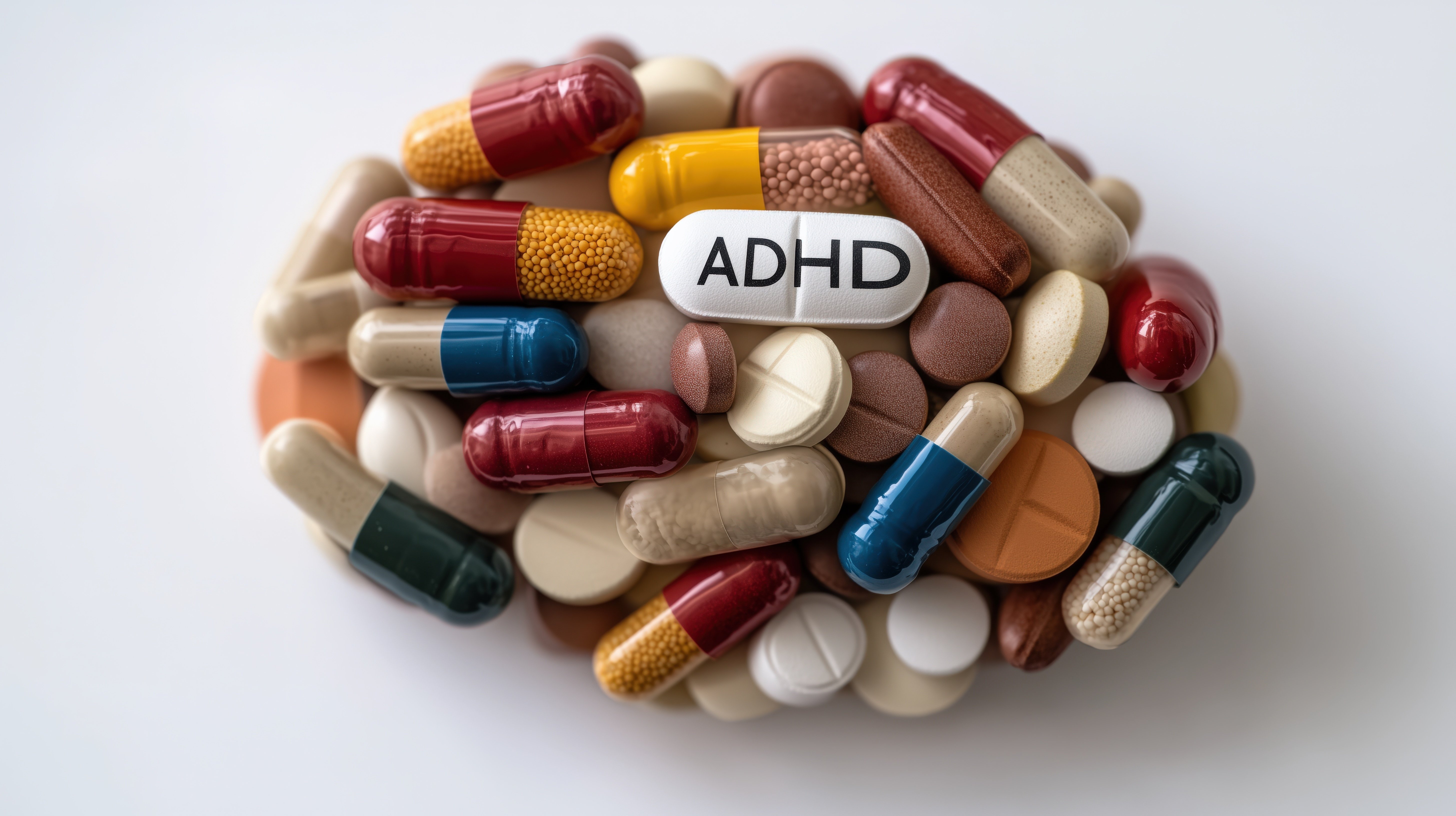Although ADHD is commonly associated with childhood, recent data confirm that it persists well into adulthood. Roughly 2.5 % of adults worldwide meet diagnostic criteria, with prevalence gradually falling to around 1 % by age 60. This decline does not necessarily mean the disorder disappears; rather, symptoms may become subtler, better masked, or less likely to be recognized by clinicians. Many adults who fall short of strict diagnostic criteria still struggle with the core difficulties of ADHD: poor focus, disorganization, and emotional volatility.
Furthermore, studies show that up to 70% of children with ADHD continue to face significant symptoms later in life, even if their diagnosis isn’t maintained.
When researchers use consistent diagnostic methods, ADHD rates look similar across continents. Yet, the number of diagnosed adults varies widely depending on healthcare systems and public awareness.
By 2025, Switzerland’s adult stimulant medication prevalence increased modestly to approximately 0.6–0.8% of the population, significantly lower than the United States, where adult stimulant use reached about 6%.
These differences might highlight variations in healthcare system approaches, cultural acceptance, and regulatory frameworks across the regions. Switzerland’s lower prevalence, despite an estimated adult men ADHD rate of 4%, suggests either underdiagnosis or greater reliance on nonpharmacologic treatments compared to the US, where pharmacological treatment is more widespread.
Diagnostic Criteria and Screening in Adulthood

ADHD in adults in Switzerland is diagnosed using criteria like the DSM-5 and requires a multimodal treatment approach, often involving medication like methylphenidate and non-pharmacological therapies such as psychotherapy and cognitive behavioral therapy.
Diagnostic standards have evolved to reflect the reality of ADHD across the lifespan and the DSM-5 (2013) lowered the number of symptoms required for diagnosis in adults from six to five, acknowledging that ADHD can look different after adolescence.
Without this change, nearly half of symptomatic adults would have been excluded from diagnosis.
The DSM-5 defines ADHD as a neurodevelopmental disorder with childhood onset. However, there is an important nuance: many people only seek help later in adolescence or adulthood, often when their coping strategies no longer meet life’s growing demands.
Clinicians are therefore encouraged not to dismiss an adult diagnosis just because a childhood history is missing. Supportive environments, strong intellect, or parental structure can easily mask symptoms in earlier years.
Modern Assessment Tools
Today’s best practice combines structured interviews with validated rating scales, such as the WHO Adult ADHD Self-Report Scale (ASRS) or the DIVA-5 interview. These help identify patterns of inattention and impulsivity across contexts. Yet, experts caution against relying solely on questionnaires as adults often underreport symptoms or misjudge their severity. Input from relatives, school records, or old teachers can help confirm early signs of ADHD before age 12.
No laboratory test or brain scan can currently diagnose ADHD. Reviews of hundreds of studies have found no biomarker—genetic, biochemical, or imaging-based—with enough sensitivity and specificity to guide clinical decisions. Neuroimaging and EEG remain useful only to rule out other conditions, not to confirm ADHD.
Emerging Digital Tools for ADHD Assessment
Digital innovation is transforming how ADHD is evaluated in clinical practice, including for adults. Although no computerized system can yet replace a full diagnostic interview, several technologies are being used as adjuncts to support assessment, enhance objectivity, and streamline workflows.
One of the best-known examples is the QbTest, a computerized performance task that measures attention, impulsivity, and motor activity through real-time motion tracking. The tool has been approved for clinical use in parts of Europe, primarily among children, but some centers now apply it to adults to provide quantifiable data on attention and hyperactivity levels.
In Switzerland, digital solutions are gradually entering routine ADHD care. Specialized clinics such as Sinaps now incorporate online self-report tools and standardized questionnaires into their adult ADHD pathways. These systems allow faster pre-assessment and triage while maintaining psychiatrist oversight. For patients facing long waiting lists, they represent a pragmatic bridge between screening and formal diagnosis.
At the international level, fully remote diagnostic models are emerging. The Mentavi Diagnostic Evaluation, for instance, offers asynchronous online ADHD assessments for adults. Recent validation data show a sensitivity of 80.6% and positive predictive value of 94.9% compared with traditional in-person interviews. Although such systems are not yet integrated into the Swiss public sector, they reflect a growing trend toward digital-first diagnostics, particularly for international and English-speaking residents.
Neuroimaging and Neurobiological Findings

Over the past decade, neurobiological research has deepened our understanding of ADHD in adults. Yet, much of what we know still builds on foundations from pediatric studies. Modern imaging has revealed that the clear brain differences often seen in children with ADHD tend to soften or even disappear in adulthood.
Meta-analyses of structural MRI data show that children with ADHD typically have smaller cortical and subcortical volumes across several regions of the brain. By adulthood, however, these differences become less distinct, suggesting that brain maturation may continue into later developmental stages—a kind of neural “catch-up.” This observation parallels clinical patterns, where some symptoms ease as individuals mature.
Interestingly, not all findings point in the same direction. Studies using diffusion MRI have identified persistent changes in white matter integrity, particularly in tracts such as the corpus callosum, among adults with ADHD. This suggests a developmental shift: while gray-matter differences may dominate in childhood, subtle white-matter anomalies could underlie the lingering cognitive and attentional difficulties of adulthood. Longitudinal research is now focusing on how these structural variations evolve over time and how they relate to long-term symptom trajectories.
Another consistent theme is heterogeneity. When researchers pool large imaging datasets, the results rarely converge on a single “ADHD brain profile.” Variations in methodology, sample size, and clinical characteristics all contribute to the diversity of findings. ADHD is now recognized as a neurobiologically heterogeneous disorder, influenced by symptom subtype, sex, comorbidity, and treatment history. This growing awareness is shifting research away from simple case-versus-control comparisons toward individualized neurodevelopmental trajectories that capture real-world variability.
At the neurochemical level, adult ADHD remains closely tied to dopamine and noradrenaline dysregulation in fronto-striatal circuits. The effectiveness of stimulant medication supports this view: methylphenidate and amphetamine compounds increase extracellular levels of these neurotransmitters by blocking reuptake and enhancing release.
As we can see, the current research is moving toward integrated models that combine brain imaging, neurochemistry, and genetics to explain why symptoms persist for some individuals but diminish in others. The ultimate goal is a future of personalized interventions guided by each patient’s unique neurobiological profile.
Treatment Options for Adults with ADHD

Effective treatment for adult ADHD is almost always multimodal, combining medication, psychological intervention, and structured lifestyle adjustments. No single strategy fits all; the best outcomes occur when therapy is tailored to individual needs, comorbidities, and life circumstances.
Stimulant Medications
Stimulants remain the first-line treatment for adult ADHD and are supported by decades of research. These agents target the dopamine and norepinephrine systems in fronto-striatal circuits, improving attention, working memory, and impulse control.
Methylphenidate-based medications, such as Ritalin® and Concerta®, act primarily by blocking dopamine and norepinephrine reuptake at the presynaptic neuron. Clinical trials consistently show a great effectiveness rate, with rapid symptom reduction and functional gains evident within days to weeks.
Amphetamine-based compounds (e.g., lisdexamfetamine, dextroamphetamine) work through a slightly different mechanism by both blocking reuptake and stimulating the release of catecholamines. Some patients respond better to one class than the other, highlighting the importance of individualized medication trials.
Dosing and titration require care. Clinicians typically start low, then increase gradually until optimal benefit is achieved without intolerable side effects. Regular follow-up is essential, as over- or under-dosing can both reduce efficacy.
Monitoring includes cardiovascular screening, blood pressure and heart rate checks, and review of sleep and appetite. Although stimulants are generally safe under supervision, patients with cardiac disease or substance misuse risk require special caution.
Recent long-term data (2025) indicate that continuous stimulant use maintains cognitive and functional benefits for most adults, with no evidence of progressive tolerance when properly monitored. However, optimal outcomes occur when pharmacotherapy is paired with behavioral strategies.
Non-Stimulant Medications
For patients who cannot tolerate stimulants or for whom they are contraindicated, several non-stimulant options exist.
Atomoxetine, a selective norepinephrine reuptake inhibitor, is the best-studied alternative. Its onset of action is slower (typically several weeks) but its efficacy is well established, particularly for adults with comorbid anxiety or sleep disturbances. Atomoxetine increases norepinephrine availability in the prefrontal cortex, improving sustained attention and emotional regulation..
Alpha-2 agonists such as guanfacine and clonidine can be used alone or as adjuncts to stimulants. They act on postsynaptic receptors in the prefrontal cortex, dampening hyperarousal and improving working memory. Their sedative and blood pressure-lowering effects, however, limit their use in some patients.
Comparative studies show response rates for non-stimulants of around 50–60%, somewhat lower than stimulants, but these agents offer valuable options for patients who require or prefer non-controlled substances.
Behavioral Therapies

Psychological and behavioral interventions are essential in the long-term management of adult ADHD. They help patients translate symptomatic relief into functional improvement in daily life.
Cognitive-behavioral therapy (CBT) adapted for ADHD focuses on practical skills: time management, prioritization, emotional regulation, and restructuring of self-critical thoughts. Evidence shows that combining CBT with medication improves both symptom control and coping ability compared to either approach alone.
ADHD coaching provides structured accountability and real-world strategy building. Coaches help patients implement systems:planners, reminders, scheduling frameworks, that sustain attention and reduce procrastination.
Mindfulness-based interventions have gained strong empirical support in recent years. Regular mindfulness training can reduce impulsivity, enhance emotional control, and improve overall well-being. Neuroimaging studies even suggest that mindfulness may normalize activity in attention-related networks.
The Road Ahead for Adults with ADHD
By 2025, research has made one message unmistakably clear: ADHD does not end with childhood. It is a lifelong neurodevelopmental condition that evolves with age and environment. For some, symptoms quieten with maturity; for others, they persist in subtler forms, masked by structure, intelligence, or sheer effort, until life’s growing demands reveal their impact.
Advances in neuroimaging, genetics, and digital diagnostics are deepening our understanding of how ADHD unfolds across the lifespan. Treatment is becoming more personalized and multimodal, integrating pharmacologic, behavioral, and lifestyle strategies that reflect each patient’s unique neurobiological and psychosocial profile.
As awareness broadens, so does the opportunity for earlier recognition and more targeted care. Clinicians identifying ADHD in adulthood now need to restore agency, stability, and quality of life for patients who may have spent years undiagnosed or misunderstood.
To stay ahead of the latest developments in adult ADHD research, diagnostic innovation, and treatment strategies, medical professionals can register at just-medical.ch.
Access CME-accredited e-learning modules, specialist webinars, and continuously updated insights from international neuropsychiatric research curated for clinicians who want to translate knowledge into better care.
Back to all blog posts
